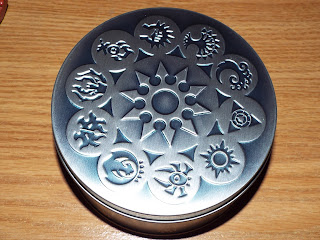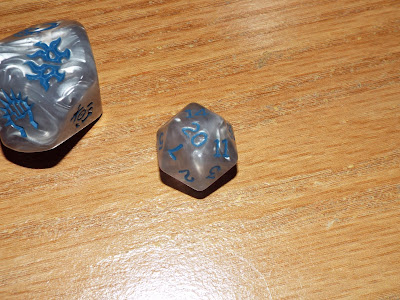Review copy courtesy of Wizards of the Coast.
Pros:
This one has more art than the
last adventure.
New class options.
New monsters.
Art is back in this one. Colours,
and tons of it. The maps that are here, such as the Tenth District
maps in particular look great. I’m happy to see the edition
continuing like this especially since I found Dungeon of the Mad
Mage lacking
in this regard.
Could Go Either Way:
New races.
If you are a
stickler for balance, you may not like some of the races here. They
generally follow the pattern of a +1 bonus, a +2 bonus, and a
race specific ability
or two that act
like a feat. The
Vedalken in particular gets advantage on saving throws for 3
different ability scores, which seems exceptionally powerful.
This
is a Magic the Gathering
setting book for D&D. When I discussing this with my group, the
first question out of their mouths was: “What? Where’s
Planescape, Eberron
or Darksun?” Okay,
technically there was a digital book released on DMs Guild for
Eberron, but they were not officially done yet. However,
as a D&D player it might be hard for you to get excited about
this particular setting when
you have so many other more storied settings (at least in D&D)
competing for your time.
This
is one of those ~250 page books. I
think in general they could push the page count closer to 300, more
like the core books. Settings
in particular should be easy to expand so far, especially if more
adventure ideas are provided.
Cons:
* Denotes nitpicking.
 |
| Cover of Guildmaster's Guide to Ravnica. |
Introduction
It
should come as no surprise that I like setting books. I
don’t run many, and
the ones I do tend to be my own creation,
but they are an interesting source of ideas, and are weirdly
fulfilling in a way. Interesting
concepts are given, and even if you do the opposite of the settings
you just read, such an exercise still comes as inspiration from the
original source. When
I heard about Guildmasters
Guide to Ravnica,
I
had
mixed feelings. Part of me was excited
to see a new setting for D&D 5th
edition. The other part of me went: “Huh? A Magic the Gathering
Setting before Planescape?” Perhaps
I’m the wrong target audience, but though I think the book is
interesting as settings ought to be, it
was a constant throughout my read.
New
Races
Well,
they have 6 new stated out races. Humans and elves return with some
new setting specific fluff, but there’s nothing mechanical here for
them. Your opinion will come
down to if you think the classes are stronger than what we’ve seen
before. The number of elements is in line with what we’ve seen
before. The Vedalken in
particular seem to be very powerful with their advantage to saving
throws for 3 different stats. And
since it’s advantage, it’ll interact with class specific saving
throws or feats which add the expertise modifier.
New
Monsters and NPCs
I’m
always happy to see some setting specific monsters and
NPCs. Of course they are
always a few changes away from being used in other settings, but hey,
that’s why I like them. You
get some more melee hitting guys, as you’d expect, however there
are some standouts. I really like how the horrors have customization
options built right into their section. In fact, I’d love to see
more of those in future books. It’s
a page efficient way to give many more options and ideas to Dungeon
Masters straight out of the box. Of course we can, and will, make our
changes but seeing changes other Dungeon Masters have tried and
enjoyed is extremely valuable. The
flavour in creatures such as a lich made from fungus really help make
me want to use some of them, even if I won’t use the setting.
The
monsters and NPCs
are also easy to transfer to different settings. New
angels, undead, demons, and cultists are a few examples. It isn’t
as incredibly long
as the Monster Manual,
but at ~70 pages long
(including fluff and lore), it’s a nice addition.
 |
| This sort of art is what I most enjoy in all these books. My picture doesn't do it justice. |
The
Setting
Imagine
a city with newspapers and plumbing, but in a state of conflict
between a bunch of different faction. However, thanks to an ancient
contract, they can’t completely wipe out another. Instead
small events spiral due to feedback and manoeuvring from all of the
factions. That’s the main sales pitch for the setting. And
it’s
a solid idea, full
of opportunity for interesting campaigns.
It’s
also the main idea, so if you wanted something else (plane hopping,
massive undead blight, going into the dangerous lands to recover
forgotten artifacts, travelling through space on a spelljammer),
you’re largely
out
of luck.
The
factions get
a lot of the page count as you’d expect. And as you’d expect, the
differences also extend into
the realm of philosophy. Their
goals and their ideals differ,
but still
it’s very possible to have a ragtag mix of different factions. It’s
a great source of ideas for factions in your games, and the section
on building villains for each faction are particularly interesting
and transferable. There’s
also some setting specific currencies. My players love that sort of
thing.
The
maps and description
of each of the precincts in the Tenth District are
really
well done. Especially
the maps. I really like the maps.
The
influence of the guilds, and the feeling of each area gets a heavy
emphasis. They
also go over crime, guard response, goods, and other aspects of the
area that together help flesh out the city. There
are even some tables for random people and rumours. You may want to
adjust the probabilities so some are more common than others, but I
think it’s a really good idea. I
hope to see Sigil get this treatment in a new book one day.
The
descriptions also don’t overstay their welcome, but I think more
explanation and exploration would of been helpful. The book makes it
seems like we only got a small part of Ravnica. With
a book so named I’d expect all of Ravnica. The
other districts didn’t need as much depth, but I think covering
them would’ve been beneficial.
 |
| A more typical example of the art found in the book. It tends to be stylized like this, but it looks good. |
Mini
Adventurer
Oh
yeah, there’s one in here. Well, if
you call 12 pages long an adventure. It’s
rather light and involves tracking down an escaped goblin gang
mastermind. Investigations,
and conflict await you in your search. I’m
glad to see an adventure here, even a small one like this. However,
I would’ve liked a bigger emphasis on the guilds and guild
interactions, since the rest of the book spends so much time building
them up. It can grow into
that, and as a new Dungeon Master you’ll appreciate it, but
I would’ve liked more. Bumping
the page content to ~300 pages would’ve
really added value.
Art and Maps
Generally, the artwork is back to what we'd expect. There's lot's of it, it's colourful, and it's purposely done to look like a painting. You can see the water colours run at the edges. Just look at any of the images I have included here. For this sort of thing seeing it is a lot better than having it described. They have a fair amount of environment and cityscape images, which tend to be my favourites. I'd also like more, but this book is more generous with artwork than Dungeons of the Mad Mage.
The maps in particular I need to call out. They look really good and I'd love to see more of this style in future books. Keep it coming. It's great. See below to see what I mean.
 |
| See what I mean? Absolutely love it. |
But
What About the Other D&D Settings?
I
briefly mentioned it in my introduction, but we haven’t seen too
much straying from the forgotten realms in this edition. We got a
little bit with Curse of Strahd,
since Barovia is in a pocket plane and corresponds to the old
Ravenloft setting, but not much outside of that.
Talking
with some of the other Dungeon Masters and players I know, the
response was generally similar. They were surprised that there would
be such a setting book come out before the other classic D&D
settings. And it is those other D&D settings that they were
interested in. If you like
Magic the Gathering
and wanted to play in that setting your opinion might vary. However,
I think that there are plenty
of other settings that people were wanting before this one.
I
had the foresight to record the setting mentioned during our
conversations. They include Planescape,
Greyhawk, Darksun,
and Sprelljammer.
Price
It’s a typical core rulebook. MSRP is
49.94, and for more information see their page
here.
As always I’d also suggest looking around, since you can often find
books for less online or on sale.
What I felt was Missing
A setting should have unique elements
that give it a special feel. And there’s usually no better way than
presenting an adventure that highlights the special elements that
make the setting shine. We have an adventure here, and I’m happy to
see it. If anything I want a couple others. I also think that giving
some short adventure outlines for inspiration would go a long way.
I’d like to see the books edge closer to 300 pages on average,
which is more inline with the core books.
They sort of do that with the section
giving some ideas and suggestions for villains in the setting, but
I’d like a little bit more. Don’t just say “a Dimir wants to
erase the memories of a humiliating event”, give a few beats that
could happen for inspiration. I guess the best way I can say it
succinctly is that I’d like some adventure ideas and outlines, not
just plot hooks.
Free Stuff
Nothing to see
here. Move along.
Summary
In general I think it’s a solid
enough book, but it very much will go over best with people who enjoy
both D&D,
Magic the Gathering,
and wanted to play in the setting. If
you aren’t it’s unlikely you’ll be interested outside of
stealing ideas and monsters from the book. My
players and acquaintances all expressed confusion, since they would
have expected and preferred
some classic D&D
settings. The concept of a
massive conflict between multiple factions, all with their own
specific methods, and goals is an interesting one. It
can easily be run with in your own home brew settings. However,
unless you are in that very specific overlap of D&D and Magic
the Gathering fan, I can’t see
you getting excited about the book. In
that case you’ll be better serviced by an adventure that also
functions as a setting companion like Out of the Abyss
or Curse of Strahd.
Other







